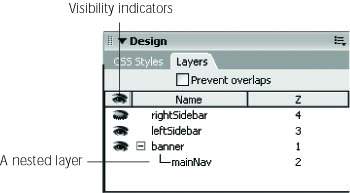8.6 The Layers Panel
The Layers panel (Figure 8-8) helps you manage the layers in a document. To open
it, choose Window Layers, or press F2. Layers, or press F2.

The panel lists all layers in the document, and the three columns provide information
on each layer:
Visibility. To change a layer's visibility, click in the column with the eye icon next
to the layer's name. An open eye indicates a layer is visible; a closed eye, hidden.
No eye icon at all represents the factory setting (that is, visible). Layer Name. If you use Dreamweaver's Draw Layer tool, Dreamweaver gives the
layer a generic name桳ayer1, for example. If you created it yourself, you probably
already came up with a pretty good name like banner or navBar. But if you want to
change that name (or provide a more descriptive name for a Dreamweaver-created
layer), double-click the layer name and type a new name. (Layer names must start
with a letter and can only contain letters and numbers. As Dreamweaver is quick
to remind you, spaces and other punctuation aren't allowed.) Clicking a layer name in the Layers panel, by the way, is another way to select a
layer in the document window. NOTE
Don't rename a layer if you've already used it in a Dreamweaver behavior like the Show/Hide Layers
action (see Section 12.4.5). JavaScript uses your layer names to "talk to" the layers. If you change a layer's name
in the Layers panel, Dreamweaver doesn't automatically update the name in the JavaScript code in your
page. The behavior, therefore, will no longer work. In that case, you'll need to edit the behavior using the
new layer name (see Section 12.2.3).
Z-Index. The Z-Index provides a third dimension to layers, letting them overlap
one another (Section 8.3.1.4). To change the Z-Index of a layer, click the number in the Z
column and type another number. Software veterans will find that Dreamweaver's Layers panel works just as it does in Photoshop or Fireworks: you can drag a layer's
name up or down the list to the desired position. The layer at the top of the list
(highest number) is in front of all other layers, while the layer at the bottom of
the list (lowest number) appears behind all other layers.
|